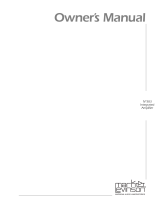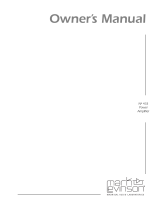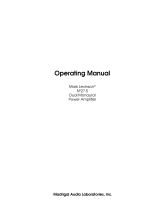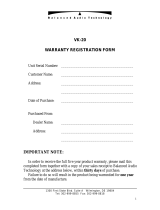Page is loading ...

Madrigal Audio Laboratories, Inc.
Operating Manual
Mark Levinson
®
Nº380S
Preamplifier

CAUTION
RISK OF ELECTRIC SHOCK
DO NOT OPEN
CAUTION: TO REDUCE THE RISK OF ELECTRICAL SHOCK, DO
NOT REMOVE COVER. NO USER-SERVICEABLE PARTS INSIDE.
REFER SERVICING TO QUALIFIED PERSONNEL.
WARNING: TO REDUCE THE RISK OF FIRE OR ELECTRIC SHOCK, DO
NOT EXPOSE THIS APPLIANCE TO RAIN OR MOISTURE.
The lightning flash with arrowhead symbol, within an equilateral triangle, is intended to
alert the user to the presence of uninsulated “dangerous voltage” within the product’s en-
closure that may be of sufficient magnitude to constitute a risk of electric shock to per-
sons.
The exclamation point within an equilateral triangle is intended to alert the user to the
presence of important operating and maintenance (servicing) instructions in the literature
accompanying the appliance.
Marking by the “CE” symbol (shown left) indicates compliance of this device with the EMC
(Electromagnetic Compatibility) and LVD (Low Voltage Directive) standards of the
European Community.
NOTICE
This equipment has been tested and found to comply with the limits for a Class B digital device, pursuant to Part 15 of the
FCC Rules. These limits are designed to provide reasonable protection against harmful interference in a residential
installation. This equipment generates, uses and can radiate radio frequency energy and, if not installed and used in
accordance with the instructions, may cause harmful interference to radio communications. However, there is no guarantee
that interference will not occur in a particular installation. If this equipment does cause interference to radio or television
reception, which can be determined by turning the equipment on and off, the user is encouraged to try to correct the
interference by one or more of the following measures:
• Reorient or relocate the receiving antenna;
• Increase the separation between the equipment and the receiver;
• Connect the equipment into an outlet on a circuit different from that to which the receiver is connected;
• Consult the dealer or an experienced radio/TV technician for help.
CAUTION: Changes or modifications to this equipment not expressly approved by the manufacturer could void the user’s
authority to operate the equipment.
The information contained in the manual is subject to change without notice. The most current version of this manual will
be posted on our web site at http://www.madrigal.com.

Important Safety Instructions
Please read all instructions and precautions carefully and completely before operating your Mark Levinson
®
power amplifier.
1. ALWAYS disconnect your entire system from the AC mains before connecting or disconnecting
any cables, or when cleaning any component.
2. This product must be terminated with a three-conductor AC mains power cord which includes
an earth ground connection. To prevent shock hazard, all three connections must ALWAYS be
used.
3. AC extension cords are not recommended for use with this product.
4. NEVER use flammable or combustible chemicals for cleaning audio components.
5. NEVER operate this product with any covers removed.
6. NEVER wet the inside of this product with any liquid.
7. NEVER pour or spill liquids directly onto this unit.
8. NEVER block air flow through ventilation slots or heatsinks.
9. NEVER bypass any fuse.
10. NEVER replace any fuse with a value or type other than those specified.
11. NEVER attempt to repair this product. If a problem occurs, contact your Mark Levinson
®
re-
tailer.
12. NEVER expose this product to extremely high or low temperatures.
13. NEVER operate this product in an explosive atmosphere.
14. ALWAYS keep electrical equipment out of the reach of children.
15. ALWAYS unplug sensitive electronic equipment during lightning storms.

4
From all of us at Madrigal Audio Laboratories, thank you for choosing the
Mark Levinson Nº380S Preamplifier.
A great deal of effort went into the design and construction of this precision
device. Used properly, it will give you many years of enjoyment.

5
Table of Contents
Unpacking and Placement ........................................................................ 6
unpacking........................................................................................................... 6
installing the batteries in the remote control .................................................... 6
placement ..........................................................................................................6
ventilation............................................................................................................ 6
Operating Voltage ...................................................................................... 7
A Quick Start… ............................................................................................ 8
Front Panel ................................................................................................... 9
Rear Panel ..................................................................................................12
building a link cable ................................................................................. 14
using a turntable............................................................................................... 15
tip polarity for external IR input ................................................................ 15
Remote Control ..........................................................................................16
Setup and Installation ................................................................................18
connections and cables ................................................................................. 18
setup overview ................................................................................................. 19
available input names..................................................................................... 19
naming an input “EQ”...................................................................................... 20
programming input names ............................................................................. 20
assigning record outputs ..................................................................................21
results of unrealistic tests................................................................................... 22
programming input offsets .............................................................................. 22
programming an automatic output (volume) level...................................... 23
programming the mute function .................................................................... 25
volume lock ...................................................................................................... 26
standby timer .................................................................................................... 27
Operational Modes................................................................................... 28
the monitor mode ............................................................................................ 28
the record select mode................................................................................... 28
the balance mode .......................................................................................... 29
balance control tip .......................................................................................... 30
Using Surround Sound Processors .............................................................31
the SSP must not come after the preamp ......................................................31
the SSP must not come before the preamp ...................................................31
the SSP must not be in a tape loop................................................................ 32
the SSP & the Nº380S ....................................................................................... 32
wiring diagram using an SSP ........................................................................... 33
noise in a/v systems..........................................................................................33
Linked Functions........................................................................................ 34
display intensity................................................................................................. 34
standby link ....................................................................................................... 34
play link ............................................................................................................. 34
record link ......................................................................................................... 34
Care and Maintenance............................................................................ 35
U.S. and Canadian Warranty .................................................................... 36
90-day limited warranty ................................................................................... 36
five year extended warranty ........................................................................... 36
Obtaining Service ..................................................................................... 37
Specifications ............................................................................................ 38
Dimensions ................................................................................................ 39

6
Unpacking and Placement
unpacking Unpack your Nº380S Preamplifier and keep all packing materials for future trans-
port. Locate and remove all accessory items from the cartons. Accessories include:
190° shielded AC power cord 1
5
⁄64" Allen key
1 Nº380S remote control 1
1
⁄8" Allen key
2 alkaline batteries
Included with your new Mark Levinson preamplifier is a pair of knit, white
gloves designed to assist you in the initial unpacking and placement of your new
purchase. Please accept them as a token of our appreciation for having purchased
one of our products.
installing the batteries
in the remote control
Using the supplied
5
⁄64" Allen key, remove the two screws in the bottom end cap
of the remote control (i.e., the end opposite the IR transmitter lens). Insert the
two alkaline batteries found in the Accessories box, being careful to follow the
polarity indications given on the inside of the battery compartment. Replace the
end cap and the screws, using the Allen key.
If at some point you notice that your remote control seems not to be performing
as well as it once did, its batteries are probably running low. Check the batteries
periodically, and replace batteries before they are “dead.” (Fully discharged batter-
ies are prone to leaking corrosive chemicals—the greenish “gunk” you may have
seen around battery terminals of other remote controls.)
placement The Nº380S should be placed close to your source equipment, thus keeping in-
terconnect cabling short. We strongly recommend shelf mounting to allow for
proper ventilation.
The Nº380S is designed for continuous operation, which is why it features a
standby mode rather than a full “off” mode—it is designed to be connected to
the AC mains at all times for the best performance.
ventilation Be sure to allow 3 to 4 inches of clearance above the Nº380S to allow heat dissi-
pation through air circulation.
Drawings are included in this manual to facilitate special installations and custom
cabinetry (see “Dimensions”).
Caution! It is extremely important that all components in your system
be properly grounded. Under no circumstances should you
defeat a three-prong AC cord with a “ground-lifter” or
“cheater” adaptor, as doing so may allow dangerous
voltages to build up between components. The presence of
these voltages would pose a threat to both your person and
your equipment.

7
Operating Voltage
The Nº380S Preamplifier is set at the factory (internally) for 100V, 120V, 200V,
230V, 220V, or 240V AC mains operation @ 50 or 60Hz. (230V/50Hz only in Euro-
pean Union countries, in compliance with CE regulations.) This voltage setting
cannot be changed by the user.
Make sure that the label on the bottom panel of the Nº380S (adjacent to the AC
cord) indicates the correct AC operating voltage for your location.
If the voltage indicated on your Nº380S is incorrect, or if you wish to change the
AC operating voltage of your Nº380S as the result of moving to a different coun-
try than the one in which you purchased your digital audio processor, see your
Mark Levinson dealer.
The Nº380S is easily powered by a normal 15-ampere AC mains line. If other de-
vices are also powered from the same AC line, their additional power consump-
tion should be taken into account.

8
A Quick Start…
We recognize that many people are understandably eager to begin listening to
their new components, and that reading the manual is often done (if at all) at a
later time—perhaps while listening to music through the new product itself. We
strongly recommend that you read this manual thoroughly, as the Nº380S Pream-
plifier incorporates many unusual features which enhance its operation.
Fortunately, we can help you get some music up and running on your system
quickly, so that you may begin enjoying your new preamplifier while reading
more about it. The goal here is simply to make some music quickly. (The follow-
ing procedure assumes that the rest of your system is already connected; e.g.,
power amplifier to speakers, etc.)
1 TURN OFF YOUR ASSOCIATED COMPONENTS
This minimizes the opportunity for a momentary electrical surge to disturb
your system while making connections. If you have a large power amplifier,
allow its power supply to fully discharge before proceeding.
2 CONNECT A SOURCE TO INPUT 1 (
INPUT 3 IF SINGLE-ENDED
)
Connect the output of your CD player to the Left and Right Input 1 XLR
jacks on the rear panel of your Nº380S preamplifier. (Use the Input 3 RCA
jacks if your source is single-ended. If used, press the Input 3 button on the
face of the Nº380S to select this input.) High quality interconnecting cables
such as Madrigal CZ Gel will yield superior results, and are strongly recom-
mended.
3 CONNECT THE Nº380S OUTPUTS TO YOUR POWER AMP
The Left and Right Main Out jacks on the rear panel of the Nº380S should
be connected to the corresponding inputs of your power amplifier. If your
power amplifier has balanced inputs and you have appropriate high-quality
cables (with XLR plugs at both ends), we recommend using the Balanced
Main Outs. Otherwise, use the (single-ended) Main Outs from the preampli-
fier to your power amplifier. Once again, high quality interconnecting cables
such as Madrigal CZ Gel will yield superior results, and are strongly recom-
mended.
4 PLUG THE Nº380S INTO THE WALL OUTLET
Connect the AC cord to the male IEC connector on the center of the bot-
tom panel of the Nº380S, then connect the AC cord to the AC mains. When
power is first applied, the Nº380S will initialize (showing all current input
names), automatically select the first available input (CD1), and set its out-
put level to OFF. (If you used input 3, select it now.)
5 TURN ON YOUR SOURCE COMPONENT; TURN ON YOUR POWER AMPLI-
FIER; SLOWLY RAISE THE VOLUME ON THE Nº380S TO A COMFORTABLE
LEVEL
Congratulations! You should now be able to enjoy your favorite music while
reading the rest of this manual.

9
display
intensity
monitor record select balance
inverted
polarity
mono
123456
standby
mode
mute
987
321 5
10
64
PREAMPLIFIER Nº 380S
Front Panel
1 DISPLAY INTENSITY BUTTON
Cycles among four levels of brightness (including “off”) for the display, al-
lowing adjustment for various ambient lighting conditions. When “off,” the
display will turn on for a few seconds whenever a setting is changed. When
used in conjunction with certain compatible Mark Levinson components,
this button will control the display intensity of all linked components. (For
more information, see “Linked Functions.”)
2 ALPHANUMERIC DISPLAY
Provides a wide range of information concerning the operational status of
the Nº380S. The information displayed depends on the operating mode the
Nº380S is in (determined by the mode button). The information displayed
is summarized below:
monitor Selected (audible) Source and Volume
record Select “RECD” and Source to be recorded
balance Direction and Magnitude of Offset
In addition, when used with Mark Levinson power amplifiers that incorpo-
rate our communications link circuitry, this display is used to indicate the
presence of a fault condition (if any) in the amplifier. Please refer to the
owner’s manual of your amplifier for more information. For more detailed
information on the preamplifier’s use of this display, see “Operational
Modes.”

10
3 MODE INDICATORS
Three LEDs give visual confirmation of the operational mode the Nº380S is
in at any moment. When the balance control of the Nº380S is “off-center,”
the balance LED remains lit as a reminder, in addition to other mode indi-
cators
that might be on to indicate either monitor or record select.
4 MODE BUTTON
Cycles among the three primary operational modes of the Nº380S: monitor
(the source being listened to); record select (the source being provided to
the Record Outputs); and balance (the relative volumes of the Left and
Right channels). Confirmation of these operating modes is given by the
mode indicators below the alphanumeric display. (See 3, above.)
5 INVERTED POLARITY INDICATOR
The polarity (sometimes inaccurately called “absolute phase”) of the output
of the Nº380S may be inverted via the Nº380S remote control, in which
case this LED will light as confirmation. A second press of the polarity but-
ton on the remote control will restore the polarity of the output to its origi-
nal, non-inverted state.
6 VOLUME KNOB
This control is normally used to adjust the listening volume, and does not
effect the level of the signal being sent to the Record Outputs. When in
balance mode, this knob is used to vary the relative output of the Left and
Right channels. It is also used during setup for various adjustments; see
“Setup and Installation.”
7 MONO BUTTON
This button toggles between stereo and mono operation. When in mono, it
activates circuitry which combines left and right input signals, and sends the
resulting monophonic signal to both left and right outputs. This circuit is
particularly useful when listening to older, monophonic source material,
since significant noise reduction is often realized by listening to mono re-
cordings in mono.
8 SOURCE SELECTOR BUTTONS
Inputs 1–6 are selected by pressing their respective buttons. When in the
monitor mode, pressing one of these buttons will select the source to be
heard (i.e., sent to the main outputs); when in record select mode, pressing
one of these buttons will select the source to be recorded (i.e., sent to the
record outputs).
9 MUTE BUTTON
Pressing the mute button will reduce the main output level of the preampli-
fier by a user-modifiable amount, ranging from 1 to 60 decibels. Pressing
the Mute button a second time without adjusting the volume will return it
to its previous setting.

11
If you adjust the volume with either the volume knob or the remote control
while mute is engaged, the preamplifier will adjust its volume from the
muted volume and disengage the mute function. (This to prevent an un-
pleasant surprise when, having increased the volume while muted, some-
one un-mutes the system.)
The factory default setting of the Mute circuit is -20 dB. (See “Setup and
Installation” for information on changing the factory default setting.)
10 STANDBY BUTTON
Toggles the Nº380S between normal operation and standby, wherein the
display is turned off, the outputs are disconnected, and all controls are in-
operable. All critical circuitry remains powered-up during standby to en-
sure immediate, optimal performance when you are ready to listen to mu-
sic.
The LED above the standby button will blink slowly when the Nº380S is in
standby, indicating that power is still being provided to the unit. (If the
Nº380S is Linked to other Mark Levinson components which are also in
standby, they will blink in unison.)

12
PUSH PUSH PUSH PUSH
right balanced
main out
right balanced
input 1
right balanced
input 2
left balanced
main out
left balanced
input 2
left balanced
input 1
right main out left main out
right
input 3
right
input 4
right
input 5
right
input 6
left
input 6
left
input 5
left
input 4
left
input 3
right
rec out 1
right
rec out 2
left
rec out 2
left
rec out 1
slave external master
communication ports
PREAMPLIFIER Nº38
designed and manufactured in U.S.A.
by
MADRIGAL S/N
2
1
2
5
7
1 3 4 4
7
6
6 3
PREAMPLIFIER Nº380S
Rear Panel
Note: All left-channel inputs and outputs are on the left of the rear panel as seen
from the front, and all right-channel inputs and outputs are on the right of the
rear panel as seen from the front. This design minimizes any possible confusion
when changing connections once the unit is installed, while also maximizing
channel separation in this dual monaural preamplifier.
1 BALANCED MAIN OUTPUTS
If your power amplifier is equipped with balanced (sometimes called “dif-
ferential”) inputs, it is best to use these balanced outputs on your Nº380S. A
balanced signal from preamplifier to power amplifier will offer the highest
possible performance with the best immunity from common-mode noise,
such as radio frequency interference (RFI). The balanced output signal is
made available by way of precision male XLR connectors (requiring female
XLRs on the preamplifier end of the interconnecting cable).
The pin assignments of these XLR-type male outputs are:
12
3
Pin 1: Signal ground
Pin 2: Signal + (non-inverting)
Pin 3: Signal – (inverting)
Connector ground lug: chassis ground
Refer to your power amplifier’s operating manual to verify that the pin as-
signments of its input connectors correspond to the Nº380S. If not, wire the
cable so that the appropriate output pin connects to the equivalent input
pin.
Connect the right-channel and left-channel balanced main outputs of the
Nº380S to the appropriate balanced inputs of the power amplifier.

13
If your system calls for multiple outputs from the Nº380S (as might be the
case for “passive” biamplification, for example), you may use balanced Y-
adapters to split each balanced output into two balanced outputs. The low
output impedance (6Ω) of the Nº380S can easily drive multiple power am-
plifiers.
2 SINGLE-ENDED MAIN OUTPUTS
Single-ended (“unbalanced”) outputs using Madrigal-designed RCA jacks are
provided for compatibility with a wide range of associated components, in-
cluding power amplifiers and electronic crossovers.
If you use the single-ended outputs, connect them to the corresponding
inputs of your power amplifier (or other device). Note that special features
of the Nº380S enable it to be used optimally with a surround sound pro-
cessor as one of its inputs. We do not recommend having a surround
sound processor follow the Nº380S in the signal path. (For more informa-
tion, see “Using Surround Sound Processors.”)
3 BALANCED INPUTS 1 AND 2
Accepts right-channel and left-channel balanced signals from source equip-
ment with balanced outputs.
The pin assignments of these XLR-type female input connectors are:
PUSH
21
3
Pin 1: Signal ground
Pin 2: Signal + (non-inverting)
Pin 3: Signal – (inverting)
Connector ground lug: chassis ground
Refer to the operating manuals of your balanced-output line-level sources
to verify that the pin assignments of their output connectors correspond to
the Nº380S. If not, wire the cables so that the appropriate output pin con-
nects to the equivalent input pin.
Note: If you won’t be using the Nº380S’ balanced inputs and need
more single-ended inputs, it is possible to fabricate a cable
to connect line-level sources with single-ended output to
these balanced inputs:
1
2
3
Male RCA
(connect to source)
Male XLR
(connect to Nº380
S
)
22-gauge
bus wire

14
4 RECORD OUTPUTS
Connect these outputs to the right-channel and left-channel tape inputs of
your recorder. Make a note of which set of record outputs you used with
which recording device. It is important to name the inputs you use and to
associate the correct record output with the appropriate recording device.
By giving the Nº380S this information, it can prevent accidental record
loops that might otherwise create disturbing feedback. (See “programming
input names” and “assigning record outputs” on pages 20-21.)
These outputs are unaffected by the output level control on the front panel
of the Nº380S, or by the source chosen to be monitored.
5 SLAVE AND MASTER COMMUNICATOR PORTS
These communications ports allow the Nº380S to “link” to certain compat-
ible Mark Levinson components. (See “Linked Functions.”)
MADRIGAL AUDIO LABORATORIES
R
REFERENCE
MONAURAL
AMPLIFIER
Nº 33
MADRIGAL AUDIO LABORATORIES
R
REFERENCE
MONAURAL
AMPLIFIER
Nº 33
slave in
master
slave out
processor
slave
master
slave in
slave out
slave in
transport
preamp
power
amp(s)
8 to 8 Link Cable
8 to 8 Link Cable
6 to 6 Link Cable
8 to 6 Link Cable
The Mark Levinson Linking system uses a Digital Audio Processor as the
Master of (and central clearinghouse for) inter-component communications.
Other components such as digital transports are connected to the Master as
“Slaves,” and can be “daisy-chained” using their Slave In and Slave Out jacks.
As the ultimate destination of all source signals, the Nº380S Preamplifier
must be the final “Slave” in the chain. (In technical terms, it terminates the
communications bus.) In turn, the Nº380S can serve as a master to an asso-
ciated compatible Mark Levinson power amplifier—hence its “Master” com-
munications port.
Thus, if the only other Mark Levinson Link-compatible component you
have is a digital audio processor, connect its master port to the Nº380S’
slave port using a “straight-through” RJ-45 cable. If there are additional Mark
Levinson Link-compatible components in the system, place the Nº380S at
the end of the chain by connecting the last slave out port to the Nº380S’
slave port. See the diagram (left) for clarification.
The RJ-45 cable needed for the Link connection between source compo-
nents and the preamplifier may be purchased from your Mark Levinson
dealer. It may also be easily and inexpensively made to length using two
RJ-45 connectors and the appropriate length (up to 100 feet/30 meters) of
RJ-45 (flat, eight conductor) cable.
RJ-45 cables and connectors are used throughout the world for both tele-
communications and computers, and are widely available at low cost. The
connectors are crimped on to the ends of the cable such that pin 1 at one
end is connected to pin 1 at the other end. Such a “straight-through” con-
nection is (counter-intuitively) made by introducing a 180° twist in the
cable between the two ends, as shown below.
building a link cable
To Nº380
S
To Mark Levinson
®
digital processor
Locking tabLocking tab
180
°
twist
The power amplifier Link connection is made using a 6-conductor Link
cable. Connect the Nº380S’ master port to the slave port of a compatible
Mark Levinson power amplifier.

15
Warning! Connecting the communication ports other than as
described in this manual can damage the Nº380S and the
associated Mark Levinson components, and will void those
products’ warranties.
6 INPUTS 3-6
Accepts right-channel and left-channel (single-ended) inputs from line-level
source equipment such as tuners, CD players, and tape decks.
using a turntable If a turntable is to be used with the Nº380S, it must be used in conjunction
with a phono preamp such as the Mark Levinson Nº25. The phono preamp
used should provide RIAA equalization and deliver a line-level signal to the
input of the Nº380S (both standard functions of a phono preamplifier)..
7 EXTERNAL IR INPUT
The Nº380S incorporates an infrared repeater input to facilitate a wide
range of installation options. If desired, the Nº380S may be placed inside a
cabinet or outside the normal line-of-sight in the listening area, with the
controlling IR signal being relayed to the Nº380S by any of a number of
commercially-available IR repeaters.
The specifications for this IR input call for a triggering voltage of 5 volts at
no more than 100 milliamps of current, with the tip of the
1
⁄8" mini-plug
having positive polarity, as below:
tip polarity for external IR input
+–
5 volts @ less
than 100 mA
If you would like more information on the possibility of using an infrared
repeater with your Nº380S, please contact your Mark Levinson dealer.

16
Remote Control
1MONO
Pressing this button will toggle the Nº380S in and out of the mono mode,
having the same effect as pressing the front panel mono button. Mono
mode activates circuitry which combines Left and Right input signals, and
sends the resulting monophonic signal to both Left and Right outputs. This
circuit is particularly useful when listening to older, monophonic source ma-
terial, at which time significant noise reduction may be realized.
modedisplay
polaritymono
12
34
56
volume mute
1
2
3
6
7
5
4
MADRIGAL AUDIO LABORATORIES
R
2 DISPLAY
Duplicates the function of the display intensity button on the front panel,
cycling among four levels of brightness (including “off”) for the display, al-
lowing adjustment for various ambient lighting conditions. (Tip: If pressed
and held for several seconds, the display button will place your Nº380S in
Standby.)
3 SOURCE SELECTION
These buttons provide remote selection of the six inputs of the Nº380S.
Pressing any of these buttons (or the volume +/- buttons) while the Nº380S
is in standby will bring it fully on and operational. These buttons are gray
instead of black to serve as a reminder of this secondary function.
4 VOLUME +/-
Raises the volume at either low speed for fine adjustments or high speeds
for larger changes. The Nº380S will slowly raise its output for the first 1.5
seconds this button is depressed, then move to higher rates of change.
Pressing either volume +/- button while the Nº380S is in standby will bring
it fully on and operational. These buttons are gray instead of black to serve
as a reminder of this secondary function.
Note that all volume and balance functions are disabled if a surround
sound processor [“ssp”] input is selected. For more information on this spe-
cial feature of the Nº380S’ design, see “Using Surround Sound Processors.”
5 POLARITY
Inverts the polarity (sometimes inaccurately called “absolute phase”) of the
outputs of the Nº380S. A second press of this button will restore the out-
puts to their original, non-inverting polarity.
6MODE
Duplicates the function of the Mode button on the front panel, cycling
through monitor, record select, and balance modes. As with the front panel
button, use it in conjunction with the Source Selection buttons when in ei-
ther monitor or record select mode and with the volume +/- buttons when
in balance mode.

17
7MUTE
Toggles between normal output level and the user-programmable mute
function, reducing the level by 1 to 60 decibels (depending on the user’s
programming). The factory default setting gives a 20 decibel reduction in
output.

18
Setup and Installation
connections and cables The Nº380S incorporates both RCA-type and XLR-type connectors for audio sig-
nal input and output.
The Madrigal-designed RCA-type connectors used for single-ended audio intercon-
nection are a great improvement over ordinary RCA-type connectors, offering supe-
rior contact integrity and mechanical locking when used in conjunction with the
Madrigal cable-mounted RCAs. The gold-plated XLR-type connectors used for bal-
anced connections are made to professional application standards.
When connecting the Nº380S to source equipment and power amplifiers, we rec-
ommend Madrigal Audio Laboratories CZ Gel Interconnect Cable. CZ Gel is avail-
able in various lengths, in purpose-designed balanced and single-ended configu-
rations. See your Mark Levinson dealer for more information.
Connect the AC cord to the male IEC connector on the center of the bottom
panel of the Nº380S, then connect the AC cord to the AC mains.
To Nº380
S
To AC mains
1
3
2
1
2
3
1 = Line (hot)
2 = Neutral
3 = Earth ground
When power is first applied to the Nº380S, the preamp will run through an auto-
matic initialization sequence which (among other things) provides a “role-call” of
the current input names (see “Names” on the next page), selects the first name
other than NOT USED or ssp, and sets the volume to OFF.
For optimal sonic performance and longevity, the Nº380S is designed to remain
powered at all times (the standby switch merely mutes the preamplifier’s outputs
and turns off the display). There is an initial break-in period of approximately
300 hours before the Nº380S achieves optimum performance.
Note: If AC mains power to the Nº380S is interrupted, the main
output will be muted. When power is restored, the initialization
sequence described above will restore the preamplifier to
normal operation, with the main output muted and the
display indicating OFF.
We recommend you allow the circuitry within your various system components
to stabilize for 1 to 2 minutes before use after such a power outage.

19
setup overview The Nº380S Preamplifier has many provisions for custom-tailoring the system’s
operation to match your preferences. The consistent method for modifying any of
these settings is to enter a setup mode by:
• pressing and holding a button for several seconds;
• the setting is then modified, either by pressing a button or turning
the volume knob;
• and then the new preference is confirmed by pressing and holding
the original button again for several seconds.
This three-step process is simple and logical, yet provides positive feedback that
your change has been accepted and saved for future use. (If you allow the
preamp to “time out” after changing something, your change will still be saved.).
To facilitate operation in complex multisource systems, the Nº380S is capable of
displaying a wide variety of names for each of its six inputs. The available names
are listed below.
available input names
NOT USED (any unused input)
ssp Surround Sound Processor
EQ Equalizer
DAT Digital Audio Tape
VCR Video Cassette Recorder
CAS Cassette
RTR Reel-To-Reel
DCC Digital Compact Cassette
MD Mini-Disc
CDR Compact Disc, Recordable
CDI Compact Disc, Interactive
SAT Satellite
PH Phono
LD LaserDisc
CD Compact Disc
TUN Tuner
AUX Auxiliary
DAC Digital to Analog Converter
DMX Digital Music Express™ (a cable radio system)
CDP Proceed™ CD Processor
DVD (depends on who you ask…)
DAP Proceed DAP
No30 Mark Levinson Nº30(.5) Digital Audio Processor
No35 Mark Levinson Nº35 Digital Audio Processor
No36 Mark Levinson Nº36(S) Digital Audio Processor
No39 Mark Levinson Nº39 CD Processor
Each name is normally followed by a number corresponding to the number of
the input being used. (The exceptions being the names like “No30” and “No35”
for the corresponding Mark Levinson products.) Thus, a DAT in Input 3 would
normally display a DAT3. In this way, you can have more than one CD player, for
example, and still tell at a glance which one is selected.
There is also a special name to indicate that an input is NOT USED.

20
The factory default input name is NOT USED for each input except CD1 and CAS3
(for “cassette in input 3”, the most common recording device); these were config-
ured for the Quick Start portion of this manual. Any or all input names (includ-
ing these) may be changed easily to match the configuration of your particular
system.
naming an input “EQ” The EQ name also deserves special mention: if your loudspeaker requires a dedi-
cated equalizer for proper operation (or if you have any other reason for using
an EQ much of the time), you may connect the outputs of the equalizer to the
input named “EQ.” By “recording” the source you wish to listen to (selecting it on
the record path), and monitoring the EQ input (selecting EQ on the monitor
path), you will be able to run all signals through the equalizer prior to listening
to them. This is usually preferable to simply placing the EQ between the preamp
and the power amp, as most equalizers perform best at a (fixed) line level—
which is what they will receive in this hookup.
Since, in this scenario, you would spend most of your time in the record path
(selecting the source to be equalized) rather than the monitor path, we have en-
abled the volume control function in the record path when the input selected on
the monitor path is named EQ. Thus, you may adjust the volume of the selected
source without having to push the mode button twice to return to the monitor
path.
programming input names To change the name of any particular input, follow these steps:
1 IN THE MONITOR MODE, SELECT THE INPUT YOU WISH TO RENAME
2 PRESS AND HOLD THE MODE BUTTON…
on the front panel until the display reads SET DATA, as below:
3 RELEASE THE MODE BUTTON; PRESS THE CHOSEN INPUT BUTTON RE-
PEATEDLY…
until the Name you desire appears in the display.
4 PRESS AND HOLD THE MODE BUTTON AGAIN…
until the display reads NEW DATA, as shown below. (Note: see Step 5 below
if you have selected an name of a device capable of recording.) This indi-
cates that your new name for that input has been stored in nonvolatile
memory. As a result, this new setting will survive power outages and other
interruptions of AC power to the preamp.
/














